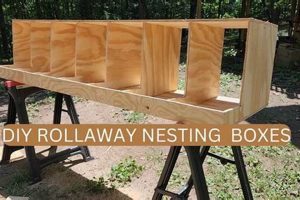The concept involves creating a Christmas tree alternative from timber, typically following specific instructions or schematics. These instructions detail the materials, dimensions, cutting techniques, and assembly methods required to construct a unique, often geometric, Christmas tree substitute. An example includes plans detailing how to cut progressively smaller wooden shelves and stack them to resemble the conical form of a traditional evergreen.
This approach to holiday decorating offers several advantages. It presents an opportunity for personalization and creative expression, allowing individuals to tailor the design to their specific aesthetic preferences and spatial constraints. Furthermore, it can be a more sustainable choice than purchasing a real or artificial tree, particularly if reclaimed or sustainably sourced wood is used. Historically, such handcrafted holiday decorations reflect a desire for individual expression and a rejection of mass-produced items.
The following sections will explore different styles and construction techniques involved in crafting these wooden holiday features, detailing various designs, the necessary tools and materials, and practical considerations for ensuring a safe and aesthetically pleasing final product. Considerations for finishing and embellishment will also be addressed.
Essential Considerations for Constructing Wooden Holiday Trees
This section outlines crucial considerations to optimize the creation process and ensure a successful outcome when implementing these decorative alternatives. Careful planning and execution are essential for both aesthetic appeal and structural integrity.
Tip 1: Material Selection: The type of wood significantly impacts the project’s aesthetic and durability. Consider hardwoods like oak or maple for longevity, or softer woods like pine for ease of cutting and affordability. Ensure the wood is properly dried and free from warping or knots in critical areas.
Tip 2: Precision Cutting: Accurate cuts are paramount for proper assembly and visual appeal. Utilize a miter saw or circular saw with a guide to achieve clean, straight lines. Double-check measurements before each cut to minimize errors.
Tip 3: Secure Joinery: Employ appropriate joinery techniques to ensure structural stability. Options include screws, nails, wood glue, or more advanced methods like dowel joints or pocket holes. Pre-drilling pilot holes prevents wood splitting when using screws.
Tip 4: Sanding and Finishing: Thoroughly sand all surfaces to create a smooth finish before applying any paint or stain. Progress through progressively finer grits of sandpaper for optimal results. Consider applying a sealant or varnish for added protection.
Tip 5: Stable Base: A stable base is crucial to prevent the tree from tipping over. Ensure the base is wide enough and weighted appropriately for the height and design of the tree. Consider using a circular or square base with rubber feet for added stability.
Tip 6: Safe Lighting Integration: If incorporating lights, prioritize safety. Use low-voltage LED lights to minimize heat generation and the risk of fire. Carefully route wires and secure them to prevent tripping hazards. Avoid using incandescent bulbs.
Tip 7: Design Considerations: Prioritize a design that complements the existing decor. Explore various patterns and styles, from minimalist geometric shapes to more elaborate, multi-tiered designs. Consider the overall size and proportions to ensure it fits seamlessly into the intended space.
Adhering to these guidelines will contribute to the creation of a visually appealing and structurally sound wooden holiday tree, offering a personalized and potentially sustainable alternative to traditional decorations.
The next section will delve into specific design ideas and project examples, providing inspiration and practical guidance for those embarking on this creative endeavor.
1. Wood Selection
Wood selection is a foundational element in the successful execution of designs for timber-based holiday trees. The choice of wood directly influences the structural integrity, aesthetic qualities, and longevity of the finished product. The characteristics inherent in different wood types density, grain pattern, workability, and resistance to decay dictate the suitability of a specific species for a given project. For instance, hardwoods such as oak or maple, known for their strength and durability, are well-suited for load-bearing components or designs intended for long-term use. Conversely, softwoods like pine or fir, while less durable, offer ease of cutting and affordability, making them suitable for projects where cost is a primary consideration or intricate designs are desired. Therefore, the selection of wood is not merely a cosmetic choice but a structural and economic decision that significantly impacts the final outcome.
The connection between wood selection and the implementation of such designs extends beyond structural concerns to encompass aesthetic considerations. The natural color, grain pattern, and texture of different wood species contribute significantly to the overall visual appeal. For example, the warm tones and pronounced grain of cedar can lend a rustic charm, while the clean, uniform appearance of birch provides a more contemporary aesthetic. Furthermore, the chosen wood’s ability to accept stains, paints, and other finishes influences the degree to which the final product can be customized to match specific decor preferences. A design calling for a painted finish might benefit from a wood with a closed grain, like maple, which will provide a smoother surface. Real-world examples, such as comparing a design constructed from reclaimed pallet wood to one built from precisely milled walnut, clearly illustrate the transformative impact of wood selection on the final appearance.
In summary, wood selection is an indispensable aspect of crafting these holiday structures. The appropriate choice ensures structural stability, allows for aesthetic customization, and dictates the overall longevity of the project. The primary challenge lies in balancing considerations of cost, availability, workability, and desired aesthetic outcomes. A thorough understanding of the properties of different wood species enables creators to make informed decisions that result in a successful and visually pleasing wooden holiday tree. This understanding links directly to the broader theme of sustainable holiday decorating, as the responsible sourcing of wood and the creation of durable, long-lasting decorations contribute to reducing environmental impact.
2. Precise measurements
The correlation between precise measurements and successful designs for do-it-yourself wooden Christmas tree projects is foundational. Deviation from accurate dimensions introduces cumulative errors during construction, potentially compromising structural integrity and aesthetic symmetry. The intended design may become distorted, resulting in a final product that fails to meet expectations or, in extreme cases, is structurally unsound. Consider a tiered tree design where each level’s diameter is slightly off; the cumulative effect could lead to a visibly warped and unstable structure. The importance of exactness is thus paramount.
Practical application necessitates adherence to specified dimensions in plans. If a plan calls for 45-degree angles on certain cuts, failure to achieve this angle precisely will prevent seamless connections between components. This manifests as gaps, uneven surfaces, or a lack of structural support. The use of accurate measuring tools, such as calibrated rulers, digital angle finders, and precision squares, is thus indispensable. Similarly, when scaling the design of a structure, whether increasing or decreasing its size, proportional calculations must be performed accurately to maintain the intended aesthetic and structural balance. Real-world examples include using cut lists and double-checking all cuts to minimize the domino effect of even minor errors.
In conclusion, precise measurements are not merely a detail but rather a fundamental component in the creation of stable and visually appealing wooden holiday trees. The consequences of inaccurate measurements extend beyond aesthetic imperfections to potential structural failures. The use of accurate tools, careful execution of cuts, and thorough verification of dimensions are essential practices. This emphasis on precision contributes directly to the project’s overall success and longevity, underscoring the crucial role of accurate measurement in these types of woodworking endeavors.
3. Secure connections
Secure connections constitute a critical element in the successful creation of wooden Christmas trees. The stability and longevity of these structures are directly contingent upon the strength and reliability of the joints connecting individual components. Inadequate joinery techniques can lead to structural failure, posing safety hazards and diminishing the aesthetic appeal of the finished product. A real-world example illustrates this point: a tree constructed with poorly glued or weakly screwed connections may collapse under its own weight or when adorned with ornaments, especially with a top heavy weight ratio.
Various methods exist for creating secure connections in wooden holiday trees, each offering different levels of strength and aesthetic qualities. Screws, when properly sized and installed with pilot holes, provide a robust and relatively easy-to-implement solution. Wood glue, particularly when used in conjunction with mechanical fasteners, can significantly enhance joint strength. More advanced joinery techniques, such as dowel joints, mortise and tenon joints, or pocket hole joinery, offer superior strength and a cleaner aesthetic, but require greater skill and precision. The choice of connection method should be informed by the overall design of the tree, the type of wood being used, and the expected load-bearing requirements. For instance, a tall, slender tree requires more robust connections than a shorter, wider design.
In summary, secure connections are not merely a desirable feature but rather a fundamental requirement for the creation of safe, structurally sound, and visually pleasing wooden Christmas trees. Selection of appropriate joinery techniques, careful execution of those techniques, and diligent inspection of completed connections are crucial steps in ensuring the project’s success. The emphasis on secure connections aligns with the broader goals of responsible craftsmanship and sustainable practices, as a well-constructed tree is more likely to endure for multiple holiday seasons, reducing the need for frequent replacements.
4. Stable base design
Stable base design is intrinsically linked to the successful execution of “diy wood christmas tree plans”. The base serves as the foundation for the entire structure, and its design directly influences the tree’s stability, safety, and overall aesthetic appeal. A poorly designed or inadequately constructed base compromises the structural integrity of the entire project, increasing the risk of tipping, especially when the tree is adorned with ornaments or positioned on uneven surfaces. Conversely, a well-engineered base provides a solid, secure foundation, enhancing the tree’s visual presence and ensuring its longevity. A direct cause-and-effect relationship exists: a weak base leads to instability, while a strong base ensures stability.
The specific design of the base varies significantly depending on the style, size, and weight distribution of the chosen “diy wood christmas tree plans”. A tall, slender design necessitates a wider and heavier base than a shorter, more compact structure. Common base designs include circular or square platforms constructed from wood, often weighted with sandbags or concrete for added stability. Other approaches involve using intersecting wooden legs or a tripod configuration. The choice of materials and construction techniques should be carefully considered to ensure the base can adequately support the weight and height of the tree. For example, a square base constructed from solid wood with mitered corners and reinforced with glue and screws provides a sturdy and visually appealing foundation. Real-world instances of instability often stem from bases that are too narrow, too light, or improperly attached to the tree structure.
In summary, a stable base design is not merely an afterthought but an essential component of successful “diy wood christmas tree plans”. The design must be tailored to the specific characteristics of the tree to ensure stability and safety. Challenges in achieving a stable base often involve balancing aesthetic considerations with structural requirements. Ultimately, a well-designed and carefully constructed base is a crucial investment in the overall success and longevity of the wooden holiday tree project.
5. Finishing techniques
The application of appropriate finishing techniques is integral to the successful realization of designs. These techniques directly impact the aesthetic appeal, durability, and overall longevity of the finished piece. Without proper finishing, the wood is susceptible to moisture damage, insect infestation, and premature wear, ultimately diminishing the lifespan of the constructed Christmas tree. The choice of finish influences the wood’s color, sheen, and texture, allowing for customization to match individual preferences and existing dcor. Therefore, finishing is not merely a cosmetic addition but a necessary protective measure that enhances both the aesthetic and functional qualities of the project.
A range of finishing options are available, each with distinct characteristics and application methods. Paints offer the widest variety of color choices and can provide a durable, opaque coating. Stains penetrate the wood, enhancing its natural grain pattern while adding color; however, they offer limited protection against moisture. Varnishes and lacquers create a hard, protective layer that resists scratches and moisture, but may require specialized application equipment for optimal results. Oil finishes, such as linseed or tung oil, penetrate the wood to nourish and protect it from within, offering a natural, matte appearance. The selection of a specific finish should consider the type of wood used, the desired aesthetic, and the intended environment. For instance, an outdoor wooden Christmas tree requires a more durable and weather-resistant finish than one intended for indoor use. A design employing reclaimed wood may benefit from a clear coat to showcase the wood’s natural character, while a modern design may call for a sleek, painted finish.
In summary, finishing techniques represent a critical phase in the implementation of “diy wood christmas tree plans”. The correct application of appropriate finishes protects the wood, enhances its aesthetic qualities, and extends the lifespan of the finished tree. While challenges may arise in selecting the ideal finish and mastering application techniques, the benefits of proper finishing far outweigh the effort required. Careful consideration of wood type, desired aesthetic, and environmental conditions allows for informed decisions, resulting in a durable, visually appealing, and long-lasting wooden Christmas tree. The importance of selecting the right finish cannot be overstated, and is a must for the succesful diy wood christmas tree plans.
Frequently Asked Questions Regarding DIY Wood Christmas Tree Designs
The following section addresses common inquiries and provides authoritative answers concerning the design, construction, and maintenance of alternative wooden holiday trees.
Question 1: What types of wood are most suitable for constructing a stable and aesthetically pleasing tree?
Hardwoods such as oak, maple, or walnut offer superior strength and durability, ideal for load-bearing components. Softwoods like pine or fir are more economical and easier to work with, suitable for less critical elements. The selection should align with the design complexity, budget constraints, and desired aesthetic outcome.
Question 2: Are specialized tools required for implementing designs of this nature?
While basic designs may be executed with hand tools, more intricate plans necessitate power tools. A miter saw or circular saw ensures precise cuts, while a drill/driver facilitates secure fastening. Clamps are essential for maintaining alignment during assembly. Safety equipment, including eye protection and hearing protection, is mandatory.
Question 3: How can the structural integrity of a wooden tree be assured, especially for taller designs?
Employing robust joinery techniques is paramount. Screws, wood glue, and dowels enhance joint strength. Reinforcing corners with metal brackets or wooden gussets provides additional stability. A wide and weighted base is crucial to prevent tipping, particularly for taller, top-heavy designs. Distributing the weight of ornaments evenly also contributes to stability.
Question 4: What safety precautions should be observed when building and displaying a wooden Christmas tree?
Eye protection and hearing protection should be worn when operating power tools. Ensure adequate ventilation when applying paints, stains, or finishes. Use low-voltage LED lights to minimize fire hazards. Position the tree away from flammable materials and high-traffic areas to prevent accidents. Inspect electrical components regularly for damage.
Question 5: How should a wooden Christmas tree be stored to ensure longevity?
Disassemble the tree, if possible, to minimize storage space. Clean all surfaces to remove dust and debris. Store the components in a dry, climate-controlled environment to prevent warping or cracking. Cover with a breathable fabric to protect against scratches and dust accumulation. Avoid storing in direct sunlight or extreme temperatures.
Question 6: What finishing options are recommended for protecting the wood and enhancing its appearance?
The choice of finish depends on the wood type and desired aesthetic. Paints provide a durable, opaque coating, while stains enhance the natural grain. Varnishes and lacquers offer superior protection against moisture and scratches. Oil finishes penetrate the wood for a natural look. Select a finish appropriate for the intended environment, prioritizing weather resistance for outdoor applications.
In conclusion, careful planning, adherence to safety protocols, and informed material selection are essential for the successful design and construction of durable and visually appealing wooden Christmas trees.
The subsequent section provides diverse design ideas and inspiration for crafting personalized wooden holiday trees.
Conclusion
This exposition has detailed essential aspects of “diy wood christmas tree plans”, encompassing wood selection, precise measurements, secure connections, stable base design, and appropriate finishing techniques. Adherence to these principles contributes to structurally sound and aesthetically pleasing results, offering a sustainable and personalized alternative to conventional holiday decorations.
Successful implementation of such projects necessitates diligent planning and careful execution. The long-term value lies in the creation of enduring, handcrafted decorations that reflect individual skill and creative expression, promoting a more mindful approach to holiday traditions.







